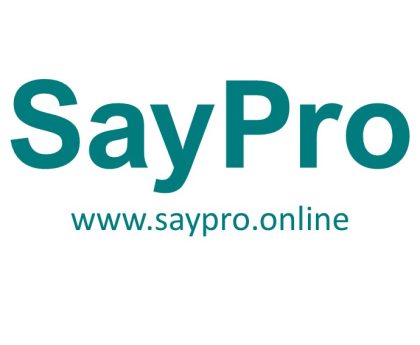SayPro Templates to Use User Feedback Template: A format for collecting structured feedback from users on their experience with the dashboard from SayPro Monthly January SCMR-17 SayPro Monthly Dashboard: Customizable dashboard for users to manage their activities by SayPro Online Marketplace Office under SayPro Marketing Royalty SCMR
The SayPro Monthly Dashboard (January SCMR-17) is designed to provide users with a customizable platform to manage their activities within the SayPro Online Marketplace. In order to ensure that the dashboard meets user needs and delivers an optimal experience, it is essential to collect structured feedback from users. The User Feedback Template is a format that helps systematically gather valuable insights on users’ experiences, challenges, and suggestions for improvement.
The User Feedback Template plays a critical role in identifying issues, enhancing features, and refining the dashboard’s functionality. This template enables the SayPro Marketing Royalty SCMR team to collect and analyze user feedback in a way that directly informs decision-making and design improvements.
Below is a detailed breakdown of the components that should be included in the User Feedback Template for the SayPro Monthly Dashboard:
1. User Information Section
Before collecting feedback, it is essential to gather basic user information that allows for segmentation and more meaningful analysis of the feedback. This section helps identify patterns based on user roles, usage frequency, or specific needs.
Required Information:
- User Name:
- The full name of the user providing feedback.
- User Role/Type:
- The user’s role within the SayPro Online Marketplace, such as:
- Seller: Managing products, sales, and inventory.
- Marketer: Managing campaigns, promotions, and advertising efforts.
- Administrator: Overseeing overall marketplace activities and user access.
- The user’s role within the SayPro Online Marketplace, such as:
- Experience Level:
- Indicate how familiar the user is with the dashboard (e.g., Beginner, Intermediate, Advanced). This helps assess if feedback is influenced by the user’s proficiency with the platform.
- Usage Frequency:
- The frequency with which the user interacts with the dashboard (e.g., Daily, Weekly, Monthly).
2. Overall Dashboard Satisfaction
This section captures the general satisfaction of the user with the SayPro Monthly Dashboard. It provides a high-level understanding of their overall experience and whether the dashboard is meeting their expectations.
Required Information:
- Overall Satisfaction Rating:
- A rating scale, typically from 1 to 5 (or 1 to 10), where 1 is very dissatisfied and 5 (or 10) is very satisfied.
- Example: “How satisfied are you with the overall dashboard experience?”
- Options: 1 (Very Dissatisfied), 2, 3, 4, 5 (Very Satisfied).
- Comments on Overall Experience:
- A text field for users to provide any additional thoughts or details about their overall experience with the dashboard.
- Example: “Please describe what you like or dislike about the dashboard.”
3. Ease of Use and User Interface
This section focuses on how user-friendly the dashboard is and how easy it is for users to navigate and interact with various elements, such as widgets, menus, and settings.
Required Information:
- Ease of Navigation Rating:
- A rating scale (e.g., 1-5) that measures how easy it is to navigate through the dashboard.
- Example: “How easy is it to find and navigate to the sections you need?”
- Options: 1 (Very Difficult), 2, 3, 4, 5 (Very Easy).
- Clarity of Layout Rating:
- A rating scale (e.g., 1-5) for evaluating how well the dashboard layout is organized and how clear it is for users to understand.
- Example: “How clear and intuitive is the dashboard layout?”
- Options: 1 (Very Confusing), 2, 3, 4, 5 (Very Clear).
- Suggestions for Improvement:
- A text field for users to suggest ways to improve the usability or interface design of the dashboard.
- Example: “What improvements would you suggest to make the dashboard easier to navigate?”
4. Feature Effectiveness
This section focuses on the specific features and widgets available in the dashboard. It helps gauge whether the features meet users’ needs and if any improvements are needed to enhance functionality.
Required Information:
- Usefulness of Widgets Rating:
- A rating scale (e.g., 1-5) to evaluate how useful each widget is to the user.
- Example: “How useful are the following widgets to your work?”
- Options: Sales Overview Widget, Marketing Campaign Widget, Performance Analytics Widget, Activity Tracker Widget.
- Options: 1 (Not Useful), 2, 3, 4, 5 (Very Useful).
- Feature Satisfaction Rating:
- A rating scale (e.g., 1-5) to measure how satisfied the user is with specific features.
- Example: “How satisfied are you with the functionality of the marketing campaign management tools?”
- Options: 1 (Very Dissatisfied), 2, 3, 4, 5 (Very Satisfied).
- Additional Features Needed:
- A text field to gather suggestions for additional features users would like to see added to the dashboard.
- Example: “Are there any features you would like to see added to the dashboard?”
5. Customization and Personalization
Since the dashboard is customizable, it is important to gather feedback on how well the users can tailor their dashboard to meet their individual needs. This section collects insights on how users interact with customization options.
Required Information:
- Customization Options Rating:
- A rating scale (e.g., 1-5) to assess how easy it is for users to customize the dashboard.
- Example: “How easy is it to customize the widgets and layout to suit your needs?”
- Options: 1 (Very Difficult), 2, 3, 4, 5 (Very Easy).
- Personalization Satisfaction Rating:
- A rating scale (e.g., 1-5) to evaluate how satisfied users are with the personalization options available in the dashboard.
- Example: “How satisfied are you with the ability to personalize your dashboard layout and widget options?”
- Options: 1 (Very Dissatisfied), 2, 3, 4, 5 (Very Satisfied).
- Suggestions for More Customization Options:
- A text field to gather suggestions on what additional customization features users would find helpful.
- Example: “Are there any additional customization options you would like to see available?”
6. Performance and Reliability
This section gathers feedback on the performance and reliability of the dashboard. It focuses on how quickly the dashboard loads, whether there are any lag issues, and how stable the system is.
Required Information:
- Performance Rating:
- A rating scale (e.g., 1-5) to assess the overall performance of the dashboard.
- Example: “How would you rate the performance and speed of the dashboard?”
- Options: 1 (Very Slow), 2, 3, 4, 5 (Very Fast).
- System Stability Rating:
- A rating scale (e.g., 1-5) to evaluate how stable the dashboard is, with a focus on crashes or unexpected behavior.
- Example: “How stable is the dashboard? Have you experienced crashes or freezes?”
- Options: 1 (Very Unstable), 2, 3, 4, 5 (Very Stable).
- Suggestions for Improving Performance:
- A text field to collect feedback on how to improve dashboard performance and reliability.
- Example: “Do you experience any issues with loading times or system stability? If so, please provide details.”
7. Support and Resources
This section assesses how well the user is able to access help or support when facing issues or questions. It also evaluates the quality and accessibility of help resources provided.
Required Information:
- Help Availability Rating:
- A rating scale (e.g., 1-5) to assess the availability and accessibility of support resources.
- Example: “How easy is it to find help when you encounter an issue with the dashboard?”
- Options: 1 (Very Difficult), 2, 3, 4, 5 (Very Easy).
- Support Experience Rating:
- A rating scale (e.g., 1-5) to assess the quality of the user’s experience with customer support or help resources.
- Example: “If you have contacted support, how satisfied were you with the assistance provided?”
- Options: 1 (Very Dissatisfied), 2, 3, 4, 5 (Very Satisfied).
- Suggestions for Improving Support:
- A text field to gather suggestions on how help resources or support services could be improved.
- Example: “How could we improve the support or help resources available to users?”
8. Additional Comments and Suggestions
Finally, the User Feedback Template should include an open-ended section for users to provide any additional comments, feedback, or suggestions that were not covered in the previous sections.
Required Information:
- General Comments:
- A text field where users can freely express any other feedback or share their thoughts on how the dashboard can be improved.
- Example: “Please provide any additional comments, suggestions, or feedback about your experience with the dashboard.”
Conclusion
The User Feedback Template is a critical tool for gathering valuable insights from users of the SayPro Monthly Dashboard. By using this template, SayPro can collect structured, actionable feedback that helps improve the dashboard’s functionality, user interface, features, and overall user satisfaction. Collecting this information on a regular basis ensures that the platform evolves to meet users’ needs, providing a better experience for everyone involved.



